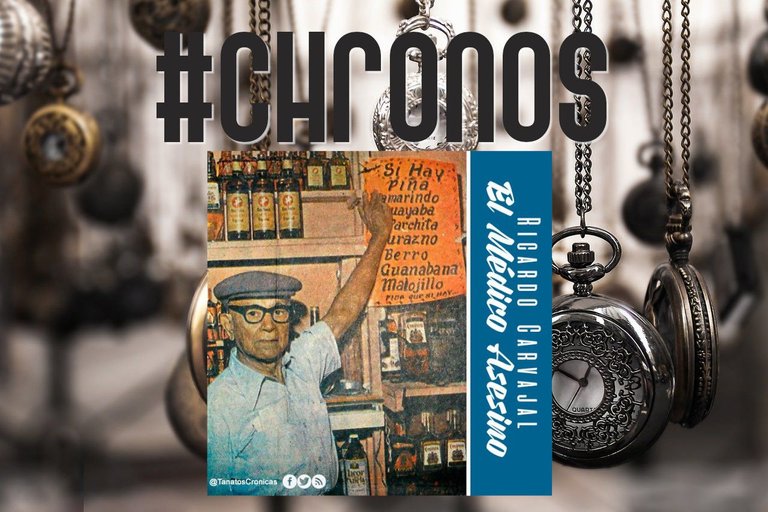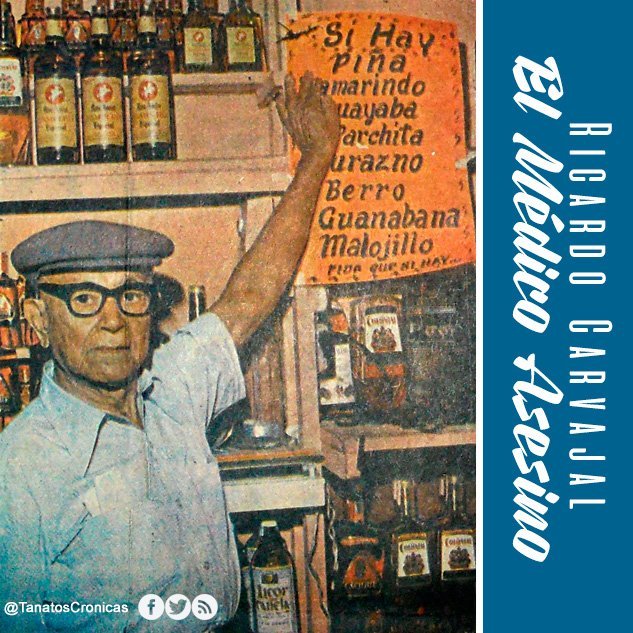En innumerables ocasiones, las leyendas se crean a partir de personas sencillas y humildes, gente que con una completa naturalidad vuelven algo cotidiano en excepcional. Arturo Carvajal fue uno de ellos, que creó con las bebidas que preparaba, una leyenda en la historia de Caracas. Nunca patentó sus inventos y ni siquiera con sus hijos compartió el "secreto" de los elíxires, pero aún años después de su desaparición física, hay quienes siguen intentando "revivir" sus bebidas y el espíritu que bordeaba su bar.
On countless occasions, legends are created from simple and humble individuals, people who with complete naturalness turn something everyday into something exceptional. Arturo Carvajal was one of them, who created a legend in the history of Caracas with the drinks he prepared. He never patented his inventions and not even with his children did he share the "secret" of those elixirs, but even years after his physical disappearance, there are those who continue trying to "revive" his drinks and the spirit that surrounded his bar.
English version below!

Las noches de la urbanización Simón Bolívar de Catia —lugar que mantenía en el vocabulario popular su nombre de Ciudad Tablitas, por el barrio que allí había antes de construir los pequeños bloques que componían— solían ser frías. Al atardecer un veía como empezaba a bajar la neblina proveniente de El Junquito, entrando por los lados de El Amparo, hasta tapar la visibilidad de los bloques de Casalta, de Propatria y desde el centro comercial se venía por la avenida El Cuartel y la avenida Bolívar, hasta cubrir por completo nuestro sector.
Pero ese frío no era razón para que los muchachos adolescentes de aquella época abandonáramos las amenas tertulias de las esquinas. Era el momento de uno buscar un suéter o chaqueta, empezar a pegar brincos en el sitio para entrar en calor, pero siguiendo en las animadas conversaciones que allí se daban sobre cualquier tema, béisbol, política, mujeres, desamor, música…
Pero cuando el frío arreciaba con más fuerza y había la posibilidad de hacer un pequeño aporte económico, se hacía la colecta y nos íbamos a donde el "médico asesino", para comprar una bebida con que calentarnos.
Uno de los lugares de encuentro era donde estaba ubicado el estacionamiento, entre los bloques 20 y 23, espacio que posteriormente convertimos en una cancha deportiva. Allí había una especie de tarima compuesta por una tanquilla eléctrica, que además de dar una vista completa al estacionamiento y/o cancha, emitía aire caliente. Por lo que en las noches frías se convertía en una calefacción natural.
Desde allí, hasta la avenida Bella Vista, donde estaba el Bar Canaima (no estoy completamente seguro si era ese el nombre), había como siete cuadras de distancia. Al reunir los 5 o 10 bolívares que costaba una botella, se enviaba una comisión a hacer la compra.
Al llegar al lugar, se podía percibir un ambiente muy particular. Se trataba de lo que comúnmente llaman un “bar de mala muerte”, pero algo te hacía sentir que había una diferencia. Una de ellas era que por allí pasaban por igual muchachos como nosotros, como políticos connotados y artistas de fama como lo eran “El Inquieto Anacobero” Daniel Santos de Puerto Rico; “El Guapachoso” cantante cubano Rolando Laserie, por nombrar solo dos de los internacionales que allí se daban cita.
Pero la fama del lugar, que para esa época ya tenía una treintena de años (fundado en los años 50), eran las famosas bebidas conocidas con el nombre de “guarapita”, las cuales, según documento que hace referencia Miro Popic, es una bebida alcohólica introducida por los franceses y en 1741 y que pronto se convirtió en la preferida de indios y esclavos.
Ricardo Carvajal, hombre de Upata (estado Bolívar), aprendió desde muchacho a preparar las guarapita tradicional. Pero luego de emigrar a Caracas es que empieza a elaborar su propia receta en la que destacaban la caña de azúcar, azúcar abundante y jugos de piña, parchita y guanábana (Había más, pero estas eran las preferidas). También adquirió gran fama su “zamurito”, una mezcla de brandy, vino y jugo de ciruelas.
Fue él, con estas bebidas, que puso a valer su famoso bar de Catia, nombre de la zona donde quedaba el sitio. Los fines de semana trabajaban toda la noche, por lo que resultaba muy oportuno para poder satisfacer cualquier “emergencia etílica” que se pudiera presentar.
Carvajal, que era un amante de la lucha libre, tenía cantidad de fotos y afiches de los más famosos luchadores. Fue precisamente de ellos que los asiduos visitantes tomaron el nombre para “rebautizar” al dueño del negocio. Todo por un chiste, pues uno de los luchadores mexicanos de fama, era conocido como el médico asesino y alguien hizo la comparación, aludiendo que de ese bar nadie salía sano y que el verdadero médico asesino era Carvajal. Según contaban en aquella época, le hicieron un bautizo al echarle encima una de las propias bebidas elaboradas por él y le quedó como nombre para el resto de la historia, el Médico Asesino.
De vuelta al barrio, armábamos la fiesta en la esquina, ya entrando en calor con las guarapitas, el aire de la tanquilla eléctrica y las conversaciones entre los amigos y conocidos que se iban congregando en el lugar, hasta la llegada del amanecer, que podía sorprendernos más ebrios o más sobrios, según se hubiera animado la noche, según el nivel de los despechos y según la cantidad de viajes que hubiéramos hecho esa noche, para reabastecernos, a la sede de médico asesino, quien nunca mató a nadie, pero a más de uno hizo caer.

English version

he nights of the Simón Bolívar urbanization of Catia - a place that kept in the popular vocabulary its name of Ciudad Tablitas , because of the barrio that was there before the construction of the small blocks that composed it - used to be cold. At dusk one could see how the fog from El Junquito began to descend, entering from the sides of El Amparo, until it covered the visibility of the blocks of Casalta, Propatria and from the mall it came along El Cuartel avenue and Bolivar avenue, until it completely covered our sector.
But that cold was no reason for the teenage boys of that time to abandon the pleasant gatherings on the street corners. It was time to look for a sweater or jacket, start jumping around the place to warm up, but continuing in the lively conversations that took place there on any topic, baseball, politics, women, heartbreak, music....
But when the cold was stronger and there was the possibility of making a small economic contribution, we would take up a collection and go to the "killer doctor" to buy a drink to warm us up.
One of the meeting places was where the parking lot was located, between blocks 20 and 23, a space that we later converted into a sports field. There was a kind of platform made up of an electric nozzle, which in addition to giving a full view of the parking lot and/or court, emitted hot air. So on cold nights it became a natural heating system.
From there, to Bella Vista Avenue, where the Canaima Bar was located (I am not completely sure if that was the name), it was about seven blocks away. When you collected the 5 or 10 bolivars that a bottle cost, a commission was sent to make the purchase.
Upon arriving at the place, one could perceive a very particular atmosphere. It was what they commonly call a "sleazy bar", but something made you feel that there was a difference. One of them was that there passed by guys like us, as well as well-known politicians and famous artists such as "El Inquieto Anacobero" Daniel Santos from Puerto Rico; "El Guapachoso" Cuban singer Rolando Laserie, to name just two of the internationals who gathered there.
But the fame of the place, which by that time was already thirty years old (founded in the 50's), were the famous drinks known as "guarapita", which, according to a document referred to by Miro Popic, is an alcoholic beverage introduced by the French in 1741 and soon became the favorite of Indians and slaves.
Ricardo Carvajal, a man from Upata (Bolivar State), learned to prepare the traditional guarapita since he was a boy. But after emigrating to Caracas, he began to elaborate his own recipe in which sugar cane, abundant sugar and pineapple, passion fruit and soursop juices stood out (there were more, but these were the preferred ones). He also acquired great fame for his "zamurito", a mixture of brandy, wine and plum juice.
It was him, with these drinks, that made his famous bar of Catia, name of the area where the place was located, worth its name. On weekends they worked all night long, so it was very convenient to be able to satisfy any "ethyl emergency" that might arise.
Carvajal, who was a wrestling lover, had a lot of photos and posters of the most famous wrestlers. It was precisely from them that the regular visitors took the name to "rename" the owner of the business. All for a joke, because one of the famous Mexican wrestlers was known as the killer doctor and someone made the comparison, saying that nobody left the bar healthy and that the real killer doctor was Carvajal. According to what was said at the time, he was baptized by pouring one of his own drinks over him and he was given the name "El Médico Asesino" (The Killer Doctor) for the rest of history.
Back in the neighborhood, we would party on the corner, warming up with the guarapitas, the air from the electric heater and the conversations between friends and acquaintances that were gathering in the place, until the arrival of dawn, which could surprise us drunker or more sober, depending on the mood of the night, depending on the level of the heartbreaks and the number of trips we had made that night, to refuel, to the headquarters of the killer doctor, who never killed anyone, but made more than one of us fall.

Este texto pertenece a mi serie #Chronos. Puedes leer más sobre la misma en Mis crónicas literarias. Si es de tu agrado este estilo y quieres sumarte a la creación de crónicas literarias, te invito a usar la etiqueta #chronos para la misma.
This writing is part of my series #Chronos. You can read more about it on My literary chronicles. If you like this style and want to join the creation of literary chronicles, I invite you to use the hashtag #chronos for it.


Vote la-colmena for witness
By @ylich

If you don't have an account at Hive yet, I invite you to read my post My Hive Testimony || Mi testimonio Hive
Si aún no tienes cuenta en Hive te invito a leer mi publicación My Hive Testimony || Mi testimonio Hive
